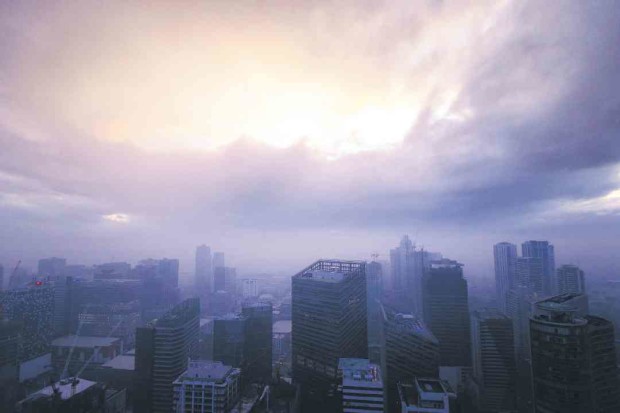You welcomed 2017 inhaling ‘extremely dangerous’ air, says DENR

THE SMOGGY MORNING AFTER A slice of the skyline in Bonifacio Global City, Taguig, on the first daybreak of the year. —JILSON SECKLER TIU
Despite the intensified campaign against the use of fireworks and firecrackers, air quality in Metro Manila got worse during the recent New Year’s Eve revelry compared to the previous celebration.
In fact, it became “extremely dangerous,” according to the Department of Environment and Natural Resources (DENR), which on Wednesday presented the results of its 24-hour monitoring from Dec. 31, 2016 to Jan. 1, 2017.
The findings covered seven areas in the capital where the DENR’s Environmental Management Bureau (EMB) had set up stations to measure the presence of particulate matter 2.5 microns or smaller, which causes hazardous smog.
The newest station in the Timog-Edsa area of Quezon City registered the highest quantity of particulate matter at 560 micrograms per normal cubic meter (ug/Ncm), said Teresita Peralta of the DENR-EMB’s Air Quality Management section.
This was followed by the station on Taft Avenue, Manila, which registered 448 ug/Ncm, compared to only 184 ug/Ncm in the same period last year.
Article continues after this advertisementThe Parañaque station registered 433 ug/Ncm, compared to 307 ug/Ncm last year; Loyola Heights, Quezon City at 369 ug/Ncm, compared to only 184 ug/Ncm last year.
Article continues after this advertisementThe reading in Valenzuela City was at 285 ug/Ncm, from 237 ug/Ncm last year; Muntinlupa at 175 ug/Ncm, from 110 ug/Ncm; and Fort Bonifacio, Taguig at 148 ug/Ncm, from 117 ug/Ncm.
DENR Undersecretary Arturo Valdez, however, pointed out that the lower figures last year could be attributed to the heavier rainfall in the capital during the monitored period.
DENR-EMB Officer In Charge and Assistant Director Jacqueline Caancan also noted that the latest figures were not the worst on record, as there were New Year’s Eve revelries in previous years that saw the amount of particulates reaching 1,000 ug/Ncm.
To be considered safe for one’s health, particulate matter levels should remain at an average of 50 ug/Ncm in a 24-hour period. Levels reaching 100 ug/Ncm are already considered unhealthy, Peralta said.
The Dec. 31-Jan.1 readings indicate the capital’s air quality to be “extremely dangerous, (which) means it is no longer deemed safe to go outside without wearing a face mask,” the DENR said in a statement.
Citing 2012 data from the World Health Organization, the agency said air pollution is the world’s largest single environmental health risk, accounting for one in every eight deaths worldwide, or approximately seven million deaths.